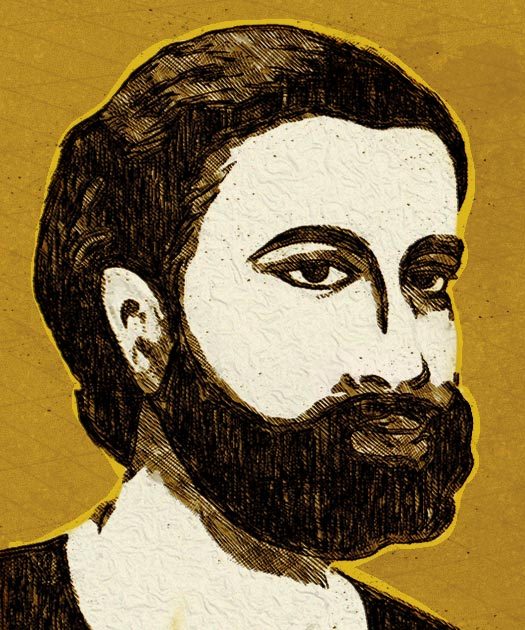Remembering Mir Taqi Mir on his 300th birth anniversary.
Salim Arif
Mir Ke Sher Ka Ahvaal Kahoon Kya Ghalib
Jis Ka Deevan Kam Az Gulshan-e-Kashmir Nahi
(What do I tell you about Mir, Ghalib
Whose poetry is no less than the beauty of Kashmir)
~Mirza Assadullah Khan Ghalib
With a vast corpus of poetry consisting of more than thirteen thousand couplets noted for their breadth and sweep, Mir Taqi Mir can be credited with setting the template of Urdu ghazal and masnavi. Known more for his ghazals, his mastery over other genres like masnavi (a long poem in rhyming couplets), qaseeda (an ode or poetic tribute) and rubaee (quatrain) is also remarkable.
Considering poetry as a vocation for those who have experienced the passion of love and wounds of grief, Mir preferred the expression of a deeply felt emotion to that of a technically embellished ornamental depiction in verse.
Sehra-e-Mohabbat Hai Qadam Dekh ke Rakh Mir,
Yeh Sair Sar-e-Koochaa-o-Baazaar Na Hove
(Tread with care in this desert of love, Mir,
This walk is not a stroll in lanes and fun fairs)
Urdu poetry had a liberal streak in its demeanour right from the beginning and Mir was the torchbearer.
Mir Ke Deen-o-Mazhab Ko Ab Poochhte Kya Ho Unne To
Qashqa Kheencha, Dair Mein Baitha, Kab Kaa Tarak Islaam Kiya
(You don’t enquire about the faith of Mir
He smeared vermillion on the forehead, sat in a temple, left Islam long ago)
It would not be wrong to say that Mir had a major role in nursing the language in the early days, helping it blossom by broadening its horizon with his diction and range.
Patta Patta, Boota Boota, Haal Hamaaraa Jaane Hai
Jaane Na Jaane Gul Hi Na Jaane, Baagh To Sara Jaane Hai.
(Every leaf and shrub, is aware of my predicament
Only the flower is oblivious, the entire garden is in the know)
Creating verse at a time when Urdu poetry was still a spoken form with handfuls of qalmi deewan (handwritten calligraphic collections), his first collection of poems was published few years after his death from Calcutta after the printing press came to India in 1800. Mir brought in a delightful synthesis of Persian and North Indian khari boli traditions with prakrit figures of speech in what then was called Rekhta (a language put together with words from several languages). Mirza Ghalib once said with envy for Mir:
Rekhte Ke Tum Hi Ustad Nahi Ho Ghalib,
Kehte Hain Agle Zamane Mein Koi Mir Bhi Thha.
(You are not the only master of Rekhta, Ghalib
There was someone named Mir before you)
Mirza Mohammad Rafi Sauda, a senior poet in terms of age and experience to him, once said that Mir nurtured and nourished Urdu language with his poetry and brought it to the level of a classical language.
Sauda, Tu Iss Ghazal Ko Ghazal Dar Ghazal Hi Keh
Hona Hai Tujh Ko Mir Se Ustad Ki Taraf
(Sauda, you compose this ghazal several times,
You need to be in the league of a maestro like Mir)
In one of his couplets, Sheikh Mohammad Ibrahim Zauq, famous Urdu poet of the Mughal court in Bahadur Shah Zafar’s time and a contemporary of Ghalib, said;
Na Hua Par Na Hua Mir Ka Andaz Naseeb,
Zauq Yaaron Ne Bahut Zor Ghazal Mein Maraa
(We could never get the style of Mir in ghazals
However hard we tried, Zauq)
The fusion of Persian elements with the lyricism of an Urdu coming of age with native vernacular colloquial shades gave Mir’s poetry a charm and style of its own.
Chashm Ho Toh Aaeena Khaana Hai Dahar
Munh Nazar Aaata Hai Deewaron Ke Beech
(If you have eyes to perceive, the world is a house of mirrors
One can see the reflection in the walls)
Using an intimate and informal tone with tu, tum, unne, pyare and sahib quite often as a form of address in his poems, Mir understood the importance of connecting with a listener in verbal communication and his poems, most of the time, take the form of a vocal address with interesting phonetic, aural structure. He never lost sight of being accessible to a lay man.
Sher Mere Hain Sab Khaas Pasand
Par Mujhe Guftugu Awaam Se Hai
(My couplets are liked by the elite
But I converse with the masses)
His autobiography, Zikr-e-Mir, reveals the bonding Mir had with his father, Ali Muttaqi, who was also a major influence in his formative years. Ali Muttaqi was married twice. A favourite of his father, Mir Taqi Mir had to endure hostility from his stepbrother. His step-uncle took care of him after he was orphaned and Mir was deprived of his due inheritance. He had to repay the loans of his father before leaving Agra as his stepbrother took control of their property.
Mir fell in love at a young age and it ended in a failure. Seeing no future with Mir, his love left him to marry another man. Nursing a broken heart, Mir left Agra after the death of his step-uncle (paternal) and came to live with his maternal step-uncle Khaan-e-Arzoo in Delhi. Aarzoo also turned hostile at the instigation of Mir’s stepbrother and Mir had to fend for himself in Delhi – events that left a permanent scar on his psyche.
Several scholars consider the content of his masnavis, Muamlat-e-Ishq and Khwab-o-Khayaal, as a reflection of what he had to be through. Khwab-o-Khayaal has a description of Mir leaving Agra an unhappy man, the pain and suffering he had to endure and the effects of his unrequited love.
Mir lived much of his life in Koocha Chelaan in the Mughal Delhi. During these years, he came under the patronage of several noblemen like Riayat Khan, Nawab Bahadur Javed Khan and Imad-ul-Mulk. Nawab Muqim Ali Khan Safdar Jung, the Prime Minister of the Mughal Empire and the Subedar of Avadh were his other patrons.
It was his reputation of a great poet that helped him manage his affairs during those turbulent times. Mir had all these patrons and people in high society who were of great help, but he couldn’t suffer fools easily even if his survival was dependent on them. This trait would create difficult situations for him regularly, turning away several of his benefactors. To Imad-ul-Mulk, his patron in Delhi, who once made Mir feel slighted by not offering him a chair to sit, he recited a few verses.
Kal Paon Ek Kasa-e-Sir Par Jo Aa Gaya,
Nagaah Voh Istikhwaan Shikaston Se Choor Tha
Kehne Laga Ke Dekh Ke Chal Raah Bekhabar
Main Bhi Kabhi Kisoo Ka Sare Pur Ghuroor Thha
(I stumbled my foot on a Skull yesterday
Shattered into pieces, it said to me
Be careful the lost one, I too was once a proud Head)
The message was not lost on Imad and Mir had to suffer. At a time when material wellbeing was of supreme importance, Mir chose to live with his values and principles. The regular plundering of Delhi and the recurring insecurities made Mir move to Lucknow to the court of Asaf-ud-Daulah at his invitation – a choice forced on Mir by the circumstances. The Delhi he had seen and left behind could never leave Mir. Distressed to witness the pillaging of his beloved Delhi, he gave vent to his feelings through some of his couplets.
Udti Hai Khaak Shehar Ki Galiyon Mein Ab Jahaan
Sona Liye Hain Gode Mein Bhar Kar Vaheen Se Hum
(Where the dust drifts in the alleys of city now, I had my lap filled with gold in the days of yore)
Mohammed Husain Azad, a fan and follower of Mir, has, in his book Aab-e-Hayaat, interesting anecdotes about his travel and stay in Lucknow. Mir sat through the long journey without uttering a word, avoiding any kind of conversation to prevent his language from getting corrupted by native expressions. His pride in his Urdu of Delhi and his utmost care to preserve his self-respect were often mistaken for arrogance by his patrons and fellow poets.
Baat Banana Mushkil Sa Hai, Sher Sabhi Yaan Kehte Hain,
Fikr-e-Buland Se Yaaron Ko Ek Aisi Ghazal Kehlaane Do
(Saying something worthy is difficult, though many couplets are composed,
Let my friends render a ghazal of inspiring heights like this)
Receiving a regular stipend from Asaf-ud-Daula, Mir had a comfortable life in Lucknow, but his intellect had to suffer. His disliking for Lucknow and its ways got worse by the day. His relations with Asaf-ud-Daula were strained. It is said that one day, Mir, at the request of Asaf-ud-Daula, was reciting a poem near a pond where the nawab was playing with the fish. After reciting a few couplets, Mir stopped. The nawab wanted him to continue but Mir said if only his majesty gave him proper attention. The nawab replied saying that anything worthy would draw his attention. It was enough for Mir to excuse himself from the court. But his stipend continued till Asaf-ud-Daula’s death. Lucknow, by then, was protected by the British forces under a treaty and the rulers felt secure to lavish their resources and think of themselves as the torchbearers of culture. Ornamental elements in romantic poems prevailed, making the form more important than content, with an emphasis on the ishq-e-majaazi (the physical side of love).
Mir was by now a recluse in the city, having an aversion to social gatherings and poetic interactions. His last three collections were put together during his stay at Lucknow and there are a number of examples of his revulsion for the way the city was taking shape.
Kharaba Dilli Ka Deh Chand Behtar Lucknow Se Thha,
Vaheen Main Kaash Mar Jaataa, Saraseema Na Ataa Yaan
(A desolate Delhi was better than Lucknow
Wish I could die there and not come for refuge here)
A lonely and somewhat reconciled Mir had to see his few friends leave him one by one.
With failing health, Mir had to live with some more misfortune. He lost his son, daughter and wife in quick succession. But writing poetry and attending an occasional mushaira kept him company. Mir fell seriously ill with a painful bowel disease that was eventually to take his life in 1810. One of his most famous ghazals from the first deevan seems to sum up his life and attitude.
Ulti Ho Gayeen Sab Tadbeerein, Kuchh Na Dawaa Ne Kaam Kiya
Dekha Is Beemari-e-Dil Ne Akhir Kaam Tamaam Kiya
(All efforts bore no fruit, neither did the medicine work
Saw the affliction of this heart take a fatal toll)
Salim Arif is a National School of Drama (NSD) alumnus credited with bringing Urdu back into the mainstream Indian theatre.


